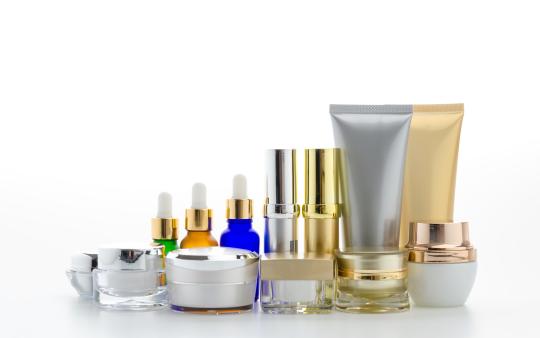I’m always surprised when I meet someone who doesn’t know that most skin care products are made from petrochemicals. This came up recently when I met a trendy 20-something-year-old photographer who worked for a local magazine. I mentioned it fleetingly in our conversation and she looked at me shocked: “They are?!” If a recent journalism grad doesn’t know about this, then who does?
A short walk down memory lane reveals that I didn’t know much about it in my early 20s either. I spent a small fortune at department store beauty counters (even though I was making minimum wage) and I never questioned what was in the product or where it came from. I suppose I imagined Swiss chemists were creating these magical formulas from rainbows and unicorns and I had 100% faith that I was getting what I paid for. With such shiny perfect packaging, how can you go wrong?
The dark history of the cosmetics industry
Up until the mid 20th century, a typical facial cream consisted of almond oil, rose water, wax, and rose essential oil. Today a typical facial cream consists of countless petrochemicals that are formulated to make a product smell good, feel good, and look good with little to no value to the skin. This shift occurred right after WWII, when the wacky world of making consumer products from petroleum became a national obsession.
The modern skin care industry is dominated by huge multinational corporations that mass produce synthetic products and spend more on marketing and packaging than what is actually going into the containers. We buy it because a beautiful celebrity or a salesperson told us to. In fact, Canada’s largest drugstore only pays a commission to their skin-care sales people for a few select brands, all of which are petrochemically based – what do you think they are going to recommend when you visit their store?
The same cosmetic chemicals that are doing absolutely nothing for our skin, are actually entering our bodies and putting us at risk for a multitude of health problems.
When I look around at people, I know that these companies have failed to make good on their promises of beautiful skin. I see so many congested, saggy, droopy faces pancaked in makeup, I just want to rub shea butter on them. But, beyond low-performing formulas, there is an even darker side to this industry. The same cosmetic chemicals that are doing absolutely nothing for our skin, are actually entering our bodies and putting us at risk of a multitude of health problems. These substances have been found in our blood, urine, breast cancer tumours, and even the umbilical cords of newborns.
Isn't the government in charge of this?
Like so many polluting industries, you have to wonder where the government is in all of this. Unfortunately, the North American cosmetic industry (including skin care, body care, hair care, deodorants, toothpaste, and sunscreen) has been self-regulated for over 30 years. The governing body, Cosmetic Ingredient Review (CIR), determines the safety of each ingredient that enters the market. They have clearly fallen short of protecting us from hazardous chemicals so environmental groups, such as the Environmental Working Group and Environmental Defence Canada, have had to step in and blow the whistle on products that we always assumed were safe.
Good news: there are alternatives
The good news is that you don’t have to buy these petrochemical products. There are literally hundreds of safe and natural brands to choose from that will nourish your skin with antioxidants, essential fatty acids, and other beneficial anti-aging nutrients. A safe bet is to purchase from health food stores and eco-boutiques that you trust. An even safer bet is to learn how to read labels so that you will be able to source potential hazards on your own.
In the simplest terms–avoid petrochemicals, limit plant chemicals, and embrace whole plant-based ingredients. Here is a simplified way of identifying where each ingredient falls:
Whole plant-based ingredients
Your BFF! Look for a Latin (scientific) name paired with ‘wax’, ‘extract’, ‘oil’, ‘water’, ‘powder’ or ‘butter’. Some companies will list the common name in parenthesis. For example, lavender essential oil would be listed as Lavendula angustifolia (lavender) oil.
Plant-based chemicals
Your “Frenemies.” Processed from coconut, palm, soy, cottonseed, or corn. Look for words with capryl, lauryl, cetyl, cetearyl, steary, glyc, coco, myristyl, palm, and suc.
Petrochemicals
Your Nemesis. Look for ingredients containing methyl, ethyl, propyl, butyl, acry, petro, PEG, MEA, DEA, TEA, BHA, BHT, or ending in "-cone" or "-eth". Others are listed as fragrance, aroma, or parfum (unless listed as essential oils only), mineral oil, paraffin, carbomer, and toluene.
The best and worst ingredients
To help you take it up a notch and become a truly savvy skin-care shopper, here’s a list of skin care ingredient functions with their “good guy” plant-based and “bad guy” petroleum-based counterparts.
Antioxidants
These ingredients do exactly what their name reads: they prevent oxidation or rancidity in a product. They are added to formulas to increase shelf life and strengthen anti-aging properties.
Whole plant-based ingredients
Rosmarinus officinalis (rosemary) leaf extract, and Camellia sinesis (tea) leaf extract, some essential oils.
Plant-based chemicals
Tocopherols (vitamin E)*, ascorbic acid/ascorbyl palmitate (vitamin C)*.
Petrochemicals
BHA (butylated hydroxyanisole), BHT (butylated hydroxytoluene).
*May be petroleum-derived. Look for statement about natural source on label.
Detergents/foaming Agents
Added to products to lift oil from surfaces and to create foam and bubbles. They are found in hand soaps, body washes, shampoos, bubble baths, and lotions. A safer, eco-friendly alternative is to use bar or liquid soap.
Plant-based chemicals
Glucosides, coco betaine, sucrose laurate, cocoyl glutamate, sodium lauryl sulfate.
Petrochemicals
Sodium laureth sulfate, cocamide DEA and MEA.
Emulsifiers
Used to bind water to oil to form lotions, creams, conditioners, and milks. They are usually comprised of a combination of a wax and detergent. If you want to avoid these ingredients, opt for facial serums and body oils to moisturize.
Plant-based chemicals
Cetearyl alcohol, stearyl alcohol and other plant-based fatty alcohols, plant waxes, soy lecithin.
Petrochemicals
Emulsifying wax NF (cetearyl alcohol with polysorbate 60, PEG-150 stearate, and steareth-20).
Emollients
Ingredients that soften skin, usually in the form of an oil.
Whole plant-based ingredients
All plant oils, butters, and waxes.
Plant-based chemicals
Caprylic capric triglycerides, fatty acids.
Petrochemicals
Mineral oil, petroleum jelly, paraffin, isohexadecane, dimethicone and other silicones, isopropyl isostearate.
Fragrance
Added to formulas to create a scent. They can be synthetic, natural, or a combination of both.
Whole plant-based ingredients
Any plant essential oils or aromatic extracts.
Plant-based chemicals
Aroma chemicals such as linalool, eugenol, vanillin, menthol, limonene.
Petroleum-based
Fragrance, parfum.
Preservatives
Added to keep products free from bacteria, mold, and yeast, they are an absolute must in any formulas that contain water.
Whole plant-based ingredients
Some essential oils.
Plant-based chemicals
Sodium levulinate, sodium anisate, gluconolactone, radish root ferment filtrate, lonicera japonica (honeysuckle) extract
Petroleum-based
Methylparaben, ethylparaben, butylparaben, propylparaben, DMDM hydantoin, diazolidinyl urea, imidazolidinyl urea, phenoxyethanol.
Thickeners
Added to products to create and maintain a more solid consistency.
Whole plant-based ingredients
Carnauba wax, soy wax, candelilla wax, floral waxes, guar gum.
Plant-based chemicals
Glyceryl stearate, xanthan gum, stearic acid.
Petroleum-based
Carbomers, copolymers.
Other Nasty Ingredients
Chemical Sunscreens
We use sunscreen now more than ever and yet the rate of skin cancer continues to climb. If you have ever had chemical sunscreen in your eye, then you have likely experienced how harsh these ingredients can be. Their purpose is to absorb sunlight and convert it into heat within your skin. Ironically, many of these ingredients create free-radicals which can lead to premature aging and cancer. One of the most ubiquitous sunscreen ingredients is oxybenzone, a known hormone disruptor and responsible for destroying reefs all over the world by bleaching the algae. Safer choices are physical sunscreens that deflect sunlight such as zinc or titanium. The safest choice is to stay out of the sun, wear hats, and cover up with clothing.
Synthetic Fragrance
Synthetic fragrance is listed on labels as ‘aroma,’ ‘parfum’ or ‘fragrance’ and may contain numerous chemicals that are not required to be identified on labels for proprietary reasons. Many of theses scents contain phthalates, synthetic musks, and other compounds that have been linked to hormonal disruption, asthma, sperm damage, behavioral problems, and cancer. They are a nuisance to many people who suffer from nausea, headaches, or asthma attacks when exposed to them. Look for products that are "fragrance-free" or that contain essential oils and/or other plant-based aromatic extracts.
Parabens
The most commonly used and controversial cosmetic ingredients in the industry, they are listed as methylparaben, ethylparaben, butylparaben, and proplyparaben. They are the esters of para-hydroxybenzoic acid and are produced synthetically from petroleum. In January 2012, a report was published by the Journal of Applied Toxicology that measured the amount of parabens in tissue samples from the mastectomies of 40 different patients. Of the 160 tissue samples tested, 158 had parabens in them – a whopping 99%. They are also reported to mimic estrogen, which can contribute to the development of breast cancer. Stay away from these chemicals.
Petrochemicals
There are so many reasons to avoid petroleum derived chemicals. First of all, they don’t biodegrade and are ecotoxic to our water systems. Secondly, they contaminate products with the carcinogen 1,4-dioxin and can cause numerous other health problems in humans. And lastly, drilling for oil and natural gas is an absolute environmental disaster for this planet. Hello tar sands!
Silicones
This is on my hit list because it can be found in basically every conventional product on the market (and even some natural brands). It coats hair to make it shiny and is added to facial creams to create a base for make-up. It is a petrochemical that bioaccumulates in wildlife and causes hormone disruption in humans. Look for dimethicone, cyclomethicone, cyclotetrasiloxane and cyclopentasiloxane.
The bottom line is that you need whole, natural ingredients on your skin to see the best results over time. The petroleum industry is not only supplying the skin care industry with substandard filler ingredients, but it also brings with it a slew of health and environmental issues. Do the right thing for your face and the planet – go natural!
*Originally published February 17, 2016









